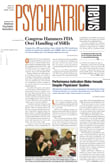The controversy over the use of medications to treat children and adolescents for depression continues to be headline-grabbing news.
In March the Food and Drug Administration (FDA) issued a Public Health Advisory stating that treatment of depression with certain medications was associated with possible worsening depression or the emergence of suicidality. (The medications at issue are bupropion, citalopram, fluoxetine, fluvoxamine, mirtazapine, nefazodone, paroxetine, sertraline, and venlafaxine.) The advisory cautioned physicians, patients, family members, and caregivers about the importance of closely monitoring patients with depression—both adults and children—who were taking the named medications, especially at the outset of treatment or when the doses were changed, either increased or decreased (FDA Public Health Advisory, March 22). As a result of the increased scrutiny and FDA requests, manufacturers of the drugs agreed to add additional warnings to the drug labels.
In August Duke University Medical Center published the results of its study, “Treatment for Adolescents With Depression Study” (TADS), which showed that 71 percent of depressed adolescent patients responded positively to a combination of antidepressant and cognitive-behavioral therapy (CBT), a much higher rate of success than that of placebo, antidepressants alone, or CBT alone (Psychiatric News, September 3).
In August the FDA moved to update its review of antidepressant drugs, with a particular focus on the possible connection between the medications and suicidality in children, through a study commissioned by the FDA and performed by Columbia University (FDA Talk Paper T04-31, August 20, 2004).
In September the FDA supported recommendations made by the Psychopharmacologic Drugs and Pediatric advisory committees regarding the increased risk of suicidality associated with the use of certain antidepressant medications by pediatric patients (see
page 1). These were among the committees' findings and recommendations:
•
There is an increased risk of suicidality in pediatric patients, and the risk applies to all the drugs studied in the clinical trials.
•
Any warning related to an increased risk of suicidality in pediatric patients should be applied to all antidepressant drugs, including those that have not been studied.
•
A “black-box” warning indicating an increased risk for suicidality in pediatric patients should be added to the labeling of all antidepressant drugs.
•
A patient information sheet should be provided to the patient and/or caregiver when an SSRI is prescribed.
•
The products should not be contraindicated in this country, because access to these therapies is important for those who could benefit.
•
The results of controlled pediatric trials of depression should be included in the labeling for antidepressant drugs (FDA statement, September 16).
Needless to say, the controversy and increasing scrutiny of prescribing practices continues to impact the physician-patient relationship. So what does all this mean for psychiatrists faced with young, depressed patients and anxious parents? How can they provide good patient care while reducing the potential for professional malpractice? What does risk management have to offer?
Now, more than ever, psychiatrists should utilize the following tried-and-true risk management strategies to increase patient safety and minimize professional liability risk. The good news is that none of this is new to psychiatrists who already practice risk management strategies.
•
Use the psychotherapeutic process to discuss important issues: Examples of the subjects that should be discussed with patients and their decision makers are the diagnosis; comorbid somatic conditions; the type of medication being prescribed; the properties, benefits, and potential side effects of the medication; and the physician's previous experience with this medication.
These discussions are also an excellent way to discover and address any special concerns of the patient and/or decision maker, as well as a powerful way to ensure that patients and/or decision makers have reasonable and realistic expectations about treatment.
•
Update informed consent: New or updated information about the risks and benefits of using a particular psychotropic medication should be discussed and incorporated into the patient's and/or decision maker's informed consent. Some may decide, based on updated information, to opt out of some treatments, try alternative medications or treatments, and so on.
•
Document: It is imperative that psychiatrists document the clinical assessment and clinical judgment that are the basis for treatment recommendations and prescribing decisions.
Document the following significant information about communications with patients and/or decision makers regarding treatment-plan recommendations, including medications: the patient's and/or decision maker's informed consent, including the discussion of the nature of the proposed treatment, the risks and benefits of the proposed treatment, the alternatives to the proposed treatment, the risks and benefits of the alternative treatments, and the risks and benefits of doing nothing.
•
Stay informed about the medications you prescribe: In addition to the sources you frequently use (for example, peer-reviewed or published studies, continuing education courses, and professional publications), the FDA's Medwatch Web site at<www.fda.gov/medwatch/safety.htm> provides continuously updated safety-information summaries about drugs.
•
Periodically, and in response to new safety information, re-evaluate the medications you currently prescribe and the clinical basis for prescribing: Update treatment plans and recommendations accordingly. Changes in medications or dosages, reassessment of patients, and closer monitoring of patients and side effects of medications may be required, among other clinical interventions. Consultation or obtaining a second opinion for complicated psychopharmacology issues should be considered.
This column is provided by PRMS, manager of the Psychiatrists' Program, for the benefit of members. More information about the Program is available by visiting its Web site at<www.psychprogram.com>; calling (800) 245-3333, ext. 389; or sending an e-mail to [email protected].▪
